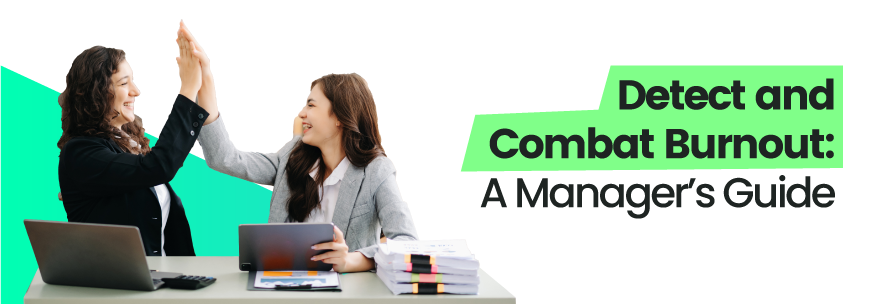
Is Your Job Stressing You Out?
A recent study found that nearly 77% of professionals experience burnout at their current job, with over 50% citing increased workloads as a major factor.
In today’s fast-paced work environments, mental health is no longer a secondary concern—it’s crucial. With rising cases of burnout, anxiety, and work-induced stress, businesses are recognizing that the mental well-being of employees directly impacts productivity and retention.
Supporting mental health isn’t just about offering perks like yoga sessions or free snacks. It’s about fostering a culture where employees feel safe to speak up, take mental health days, and access support. Offering wellness resources, flexible working conditions, and a positive environment can reduce stress and keep teams thriving.
The mental well-being of employees is a cornerstone of high engagement levels.
As the pressure to perform continues to rise, the implications are significant not just for individuals but for companies too—burnout is linked to higher turnover rates, decreased engagement, and costly absenteeism.
So, how do we take control and flip the script on workplace stress? In this blog, we’ll explore strategies to help identify stressors, combat overwhelm, boost well-being, and create a healthier work-life balance.

What’s driving this rise in workplace pressure and employee burnout, and how can both employees and employers adapt to create a sustainable work culture?
Employee Burnout Cause #1: High-Demand Workplaces
With the rise of global competition, hybrid work expectations, and technological advancements, the line between work and personal time has further blurred, with increased demands on workers to be ‘always on.’
Today’s high-demand work environments are characterized by:
- Long Hours: Employees in high-demand roles are working an average of 48+ hours per week, significantly above the standard.
- Tight Deadlines: Unrealistic deadlines can snowball, missing one target puts employees behind on everything else, increasing stress levels.
- Performance Pressure: The expectation to consistently deliver high-quality work is driving anxiety and stress across industries.
- Blurring Boundaries: Hybrid and remote work has contributed to the erosion of work-life boundaries, with many employees struggling to switch off after hours.
Professionals are finding themselves stretched thin, balancing multiple tasks while trying to meet skyrocketing expectations. The pressure to perform has created an environment where burnout, stress, and mental health challenges are becoming more common than ever.
But, pressure isn’t the only factor weighing down today’s workforce.
Employee Burnout Cause #2: Toxic Workplaces: A Silent Stressor
Recent news about the disturbing consequences of burnout have reignited discussions around toxic workplace cultures and their devastating effects on employee mental health. From lack of trust and micromanagement to a culture of fear and negativity, toxic workplaces can be harmful to both mental health and productivity. Want to know if you’re in one? Read our blog feature – Warning! These Everyday Behaviors Signal a Toxic Work Environment.
Employee Burnout Cause #3: Return-to-Office Mandates
As companies transition back to 5 days in-office work weeks, many employees are feeling the stress. The shift back to commuting, stricter schedules, and less flexibility can take a toll on mental health. It’s essential for businesses to recognize this and offer solutions that ease the transition. Read more about the psychological impact of mandates and how it can affect employee well-being and what needs to be done in the article – From Virtual to Physical Spaces: Mental Health Musts for the 5-Day Office Transition.
Spotting the Early Signs of Burnout
Burnout is more than just fatigue—it’s a chronic state of physical and emotional exhaustion that can severely impact an employee’s well-being and productivity and over time, this can compound, leading to long-term health complications. Recognizing burnout early can help mitigate its impact. It is crucial for managers and leaders to spot the early warning signs of burnout to prevent long-term damage to both individuals and the organization.
Some of the Early Warning Signs of Burnout:
- Emotional Exhaustion: Employees may feel drained, overwhelmed, and unable to cope with work demands.
- Decreased Productivity: A noticeable decline in productivity, creativity, and attention to detail can be a red flag.
- Disengagement: Burnt-out employees often feel detached from their work, showing signs of cynicism or indifference.
- Increased Cynicism: A negative attitude toward work, colleagues, or the company.
- Frequent Absences: More sick days, coming in late, or leaving early can signal mental and physical strain.
- Physical Symptoms: Like mood swings, difficulty in focussing, headaches, and health disorders due to mental fatigue.
- Decline in Communication: Withdrawing from conversations or social interactions, could signal burnout.

Managers play a critical role in spotting and addressing burnout before it worsens. Here are key strategies to help leaders identify burnout in their teams:
- Regular Check-Ins: Frequent one-on-one meetings can help managers gauge employees’ stress levels and workload.
- Recognizing Symptoms: Spotting signs like disengagement, decreased performance, emotional exhaustion, and physical symptoms.
- Encourage Open Communication: Create a safe environment where employees feel comfortable sharing their struggles without fear of judgment
- Monitor Workloads: Be mindful of team members who consistently take on excessive tasks or work long hours, as this can lead to burnout.
- Encouraging Breaks and Time Off: Promote a culture that values rest and recovery by encouraging employees to take regular breaks, vacations, and time off.
By staying alert to the signs of burnout and fostering a supportive work environment, managers can help their teams maintain both mental and physical well-being, ensuring long-term productivity and job satisfaction.
Mastering Work Stress: Practical Approaches for Employees
Shifting to the employee’s perspective – in today’s fast-paced work environment, stress may be inevitable, but it doesn’t have to be overwhelming. Here are practical strategies to manage workloads, prioritize mental health, and regain control of work life.
The first step is being aware of how you feel and identifying your stressors.
Are You Feeling Work-Stressed?
Look out for these subtle signs:
- Constant worry
- Constant fatigue or low energy
- Health issues like – headaches, trouble sleeping or changes in eating habits
- Rapid heart rate during work tasks
- Feeling inadequate or low self-esteem
- Decreased interest in work
Next, recognizing and documenting stressors can help you pinpoint what’s bothering you. These stress triggers may include an uncomfortable workspace, or colleague, background noise, or even a lengthy commute.
Pro tip: Identify what’s causing stress by keeping a journal. Documenting stress triggers, reactions, and possible solutions can provide clarity on how to better handle them.
Actionable Strategies to Manage Work Stress
- Ease Back into Full Workweeks: If you’ve been on a flex or hybrid schedule – transitioning back to full workweeks can be overwhelming. Focus on pacing yourself, and ask for a work mode that encourages gradual adjustment, if required.
- Prioritize Workload Management: Overwhelmed by too many tasks? Speak up about how to better distribute responsibilities within the team.
Pro tip: Clear communication and task prioritization can ensure no one feels overloaded, helping everyone work more effectively.
- Realistic Goal-Setting: Quality trumps quantity. Advocate for realistic performance metrics and deadlines that encourage thoughtful work rather than a rushed approach. This not only reduces stress but also improves outcomes.
- Encourage Breaks & Downtime: Don’t forget to take breaks – your brain needs time to recharge! Advocate for a culture that values mental health days and encourages regular downtime.
Pro Tip: Taking small breaks during your day, like listening to a podcast or stepping away from your desk for a bit, can help prevent burnout.
- Work-Life Boundaries: Flexibility can be a game-changer when it comes to managing stress. If possible, ask for more flexible hours to juggle both personal and professional demands without feeling burned out.
- Build a Support Network: Having trusted people to lean on – whether family, friends, or colleagues – can lighten the emotional load during tough workdays.
- Challenge Negative Thinking: Stress can lead to automatic negative assumptions. Practice stepping back from negative thoughts and observing them without jumping to conclusions.
- Self-Care & Relaxation: Prioritize sleep, mental breaks, and healthy habits to recharge and tackle work more effectively.
- Let Go of Perfectionism: Constantly striving for perfection can lead to burnout.
Pro Tip: Focus on progress, not perfection, and accept that mistakes are part of growth.
- Seek Support from Leadership: Openly communicating with your boss about feeling overwhelmed can lead to solutions. If you’re unsure how to start, HR may help navigate the conversation.
The takeaway: Unaddressed work stress can result in emotional and mental difficulties, as well as reduced productivity.
To manage job-related stress to avoid burnout – Take period pauses during the day, strengthen your support network, engage in relaxation techniques, set work-life boundaries, and ask for support when you need it.
Fostering a Culture of Work-Life Balance: The Key to Long-Term Employee Satisfaction
Fostering a culture of work-life balance (WLB) is no longer a perk — it’s a necessity. Companies that prioritize WLB not only support the mental and emotional well-being of their employees, but they also reap the benefits of a more engaged and loyal workforce.
Long-Term Benefits of Work-Life Balance:
- Increased Productivity
- Higher Retention Rates
- Enhanced Job Satisfaction
For work-life balance to become part of an organization’s DNA, leadership must lead by example. Managers and leaders who take time off, respect after-hours boundaries, and refrain from sending late-night emails set a powerful precedent for their teams. This modeling encourages employees to prioritize their own well-being without the fear of judgment or backlash.
Implementing mental health support programs and employee assistance services can provide an additional layer of support for employees dealing with stress. These programs might include:
- Access to mental health professionals
- Workshops focused on stress management
- Flexible scheduling for those dealing with personal or family issues

According to recent studies, 47% of Gen Z employees plan to leave their jobs within the next two years if they don’t achieve a better work-life balance. Job satisfaction and flexibility are increasingly becoming more important than salary, signaling a critical shift in workforce expectations. Companies that fail to recognize and address this trend risk losing top talent to competitors who offer more balanced, fulfilling work environments.
For more about this read
Building a Resilient Workforce
Building a resilient workforce is about creating an environment where employees feel supported, valued, and empowered to manage their mental well-being. By fostering open communication around mental health, offering continuous learning opportunities, and investing in comprehensive wellness programs, companies can reduce burnout and build a culture of long-term success.
In the face of relentless hustle culture and rising burnout, concepts like Bare Minimum Mondays, the 3-3-3 Perk, and Quiet Vacationing are gaining traction. These trends mark a shift in mindset, where employees are prioritizing self-care and well-being over rigid productivity metrics. The movement toward slower, more mindful work habits is not just a rebellion against burnout—it’s a redefinition of success in the modern workplace. For more about how these trends are reshaping the work culture and promoting healthier lifestyles – stay tuned for our blog feature – From Monday Blues to Bare Minimum Mondays – The Evolution of the Post-Pandemic Work Week.
